Failures of radio equipment can be repaired independently. This method involves quickly solving problems and saving money. Using the instructions below, it is easy to perform high-quality repairs of the motion sensor yourself.
Detailed comments will help you reproduce certain technological operations without errors.
Once again about sensor circuits
So, I will give the most popular motion sensor circuit again:
Motion sensor circuit 3
This diagram was sent by my regular reader Alexander from Korolev in December 2014, for which I thank him again. I will rely on this diagram throughout the text of the article, since it is the most typical. It should not be confusing that the circuit in our example will be scattered across two boards - low-current and power.
At the end of the article, a refinement of this scheme will be given.
Now I’m publishing photos of motion sensor boards sent by another reader of mine, Renat.
Low current motion sensor board
Motion sensor power board
Here is our correspondence with Renat:
- Renat: Hello! According to the diagram and description, I have the same sensor, I don’t know the exact model, they asked me to look at it, “it stopped working.” I settled on the power board. I checked all the elements, after the diode bridge + 24V comes out, the zener diode outputs + 8V, unsoldered the second part of the circuit (the board with the IR receiver, microcircuit, etc.). And now, I can’t understand why the relay activates when I apply voltage?
- Me: Is there an integrated stabilizer (KREN) type 7808, at the output 8V? You need to connect everything and then check it. When nothing is applied to the input of the key transistor, it can behave unpredictably. Check the power transistor, relay, adjustment elements, soldering. To go deeper - you need to understand the circuit - opamps, sensors, etc.
- Renat: Hello Alexander! An integral stabilizer is not worth it. I connected it, everything is still the same (the relay is activated, does not respond to the sensor, adjusting the sensor, time and “day”/”night” mode also does not change anything.
Renat did a great job with his own hands, and I will try to help him in this article.
Symptoms of a problem
Unauthorized activation
The detector triggers falsely most often due to external influences; this rarely happens due to a malfunction of the device.
To detect a malfunction in the operation of the sensor, special devices are used, which make it possible to determine how correctly the sensor is working, or they replace incorrectly functioning detectors with new devices.
Reasons for false positives:
- incorrect sensor installation
- weak contacts
- Functional parameters are incorrectly adjusted.
If the device is used together with a lamp, then the reason for the unauthorized switching on of the light may be the light bulb. LED lamps are better suited because they do not react to power surges and turn on instantly. Street fluorescent lamps flicker and do not always light up.
Does not turn off the light lamp and/or does not turn on the light lamp
If the detector does not turn off the lighting after a specified time interval, then it is worth checking the device. Such malfunctions are typical for cheap devices. Or the breakdown occurred due to the fact that the detector has been in use for a long time.
The longer the service life, the greater the likelihood that the scanning range will become increasingly shorter. Initially, the vision range is 5 meters, gradually it decreases to 3-4 meters. Over time, the lens becomes cloudy and recognizes objects less well, and the sensor may not correctly detect the light level.
It is recommended to inspect the device and rule out all of the above reasons. If the lamp and detector still do not work, then the device or the entire structure is replaced. It’s worth choosing an inexpensive but high-quality device and forgetting about this problem.
Where to start repairs if the sensor does not work
These arguments and methods of mine apply not only to a specific motion sensor, but also to many electronic devices. For example, to a light sensor, the circuit of which is much simpler, but the principle is the same.
1. Check that the connection is correct. At this stage, you also need to find out why the motion sensor does not work and under what circumstances. Options (brainstorming):
- leap of light,
- turned off the electricity
- construction work,
- an electrician came to the neighbors,
- some kind of smell
- the children were spinning
- hit
- the dog chewed
- neighbors flooded
- there was wind yesterday
- sometimes it didn't work well
- etc.
At this stage, it is already possible to identify the direction in which to move further.
You need to check that the connection is correct, make sure that the sensor is receiving the correct power, and if there are indicators, they should be on. Some. Sometimes. Next, simulate a situation in which it should work.
2. Correct adjustments. The regulators may be installed incorrectly, and it is enough to adjust the sensor correctly. To do this, it is necessary to put the controls in positions in which it is most likely to turn on: Set the illumination level to a position at which the sensor will operate both day and night. Set sensitivity to maximum. Set operating time to minimum. In any case, it’s worth turning the controls and analyzing how the sensor behaves and whether it reacts at all.
False alarm
Over time, the infrared sensor can take on a life of its own. Regardless of whether there is movement in the room or not, it automatically turns the lights on and off. False positives can be caused by both direct and indirect reasons. These can be powerful heat flows emanating from various heating equipment, or jets of cold air from air conditioners. Therefore, when installing the device, you should avoid close proximity to ventilation and air conditioning systems. The multilens should not be exposed to direct sunlight, which can interfere with the detector settings.
Operating principle of the IR detector:
Excessive cluttering of the viewing area of the device with furniture or other large objects can cause involuntary switching off or, conversely, switching on the lighting. Also, the increased sensitivity of the DD will cause it to be triggered by the movement of pets and even flying parrots. To prevent this from happening, the sensor is installed in the place of maximum access to the entire internal space of the room and the sensitivity level is reduced by turning the SENS screw counterclockwise.
Opening the sensor
If after the first stage the sensor does not work, you need to get down to real work.
We open the sensor and look at the boards. The first thing you need to pay attention to is the integrity of the elements. In addition, the smell will tell a lot to a knowledgeable person. There should be no suspicious parts - darkened, cracked, swollen, loose.
The PCB tracks must be intact. Sometimes it happens that they crack or break near the ration points (nickels). And of course, if the track is burnt out, you need to restore it with a jumper and analyze the reason.
We carefully check the soldering. In case of the slightest suspicion, we shake the suspicious parts and solder these places. Often the input wires and wires between the boards are sealed off, as well as adjusting elements (variable resistors).
What you need to know and be able to do
Before you start repairing an electrical appliance, you need to check that it is working properly. To do this, you need to know its structure, the location of the component parts and the connection diagram. If the sensor was installed by the previous owner, then you should study the passport data. The documentation provides detailed instructions for installation and adjustment, as well as a diagram for connecting the device to the electrical network and the lamp. If there are none, everything can be found on the Internet under the DD brand.
Typical DD scheme:
Test run
Connect power to the sensor. I recommend using an incandescent light bulb with a power of 25-60 W as a load to indicate the operation of the sensor. Otherwise, if you focus on the clicking of the relay, you may not hear or understand whether it is on or off. Now we check the relays and connections.
I highly recommend turning on any devices during repairs through the minimum possible circuit breaker. In this case - 1-2 Amperes. This is necessary to avoid troubles.
A better option is to connect through a transformer (with an output voltage of 220V) or a difavtomat, this will significantly reduce the risk of electric shock (we will work with open live parts!).
Another option is through a 60-100W incandescent light bulb, this will save you from a short circuit. But it's not convenient.
I recommend your article on the use of circuit breakers.
We check that the required supply voltage is present on the power board.
I won't tell you how to use measuring instruments or how to check parts. If you have questions, write in the comments.
In addition, I urge you to be careful and remember your safety! During repairs it may get fucked up!
Once again we return to where we started the repair (point 1). There is a high probability that after inspection, soldering, and replacement of visually faulty parts, everything will work.
Typical faults
There are several signs by which it is concluded that there are interruptions in the operation of the device:
- the detector turns on at any time without any reason;
- does not turn off the lamp when the conditions for sensor operation are not met;
- relay contacts do not close when the sensor is operating
- stops responding in the presence of moving objects
- the sensor operates and turns off spontaneously, regardless of the environment
Doesn't turn on
If the detector does not work or the light does not come on, then first check whether it is connected correctly. Next, try to remember or find out when the sensor stopped working and under what conditions this happened. Reasons for malfunction of the device:
- voltage drop in the network
- water got on the detector: it rained or there was flooding from neighbors on the floor above
- mechanical impact in the form of a blow
- power outage in the area
- Unstable operation of the device has occurred before
Having established the cause of the disruption, it will become clear what to do next.
Doesn't turn off
Lighting that burns around the clock is not required in apartments and private houses. It makes sense to spend time and try to repair the sensor. Often the root of the problem lies in closed relay contacts, which happens due to violations of the connection rules or installation by an inexperienced specialist. Also find out what is located opposite the motion sensor. There should be no devices that emit heat near the operating detector. After all, it is known that the device is triggered when the thermal environment changes. Do not place a heater or other devices that generate heat in front of the appliance.
Common reasons:
- It is recommended to check the time delay adjustment. The power circuit does not open if the delay regulator is set to too high a value;
- setting the brightness threshold (LUX) too high;
- there is a peculiarity in the operation of the detector's electrical circuit. If the sensor is not new and has been in use for a long period of time, the contacts do not open because there is a residual load. If the device does not turn off the light, you should disconnect the sensor from the mains voltage for half a minute;
- The degree of sensitivity of the motion sensor to infrared waves (SENS regulator) is incorrectly adjusted;
Recommended values are indicated in the technical documentation; it is important to use them. If the dimmer is set to maximum (2000 lux), the light stops turning off. The operation of the device loses all meaning
If you don't know what the values should be, you shouldn't change them yourself. The best solution is to contact a professional for help with setup.
Unpredictable on and off
When high-frequency radio signals appear in the scanning area of the sensor, the device begins to operate unstably. In this regard, it is not recommended to place the detector where devices that generate radio waves (for example, a WIFI router) operate. In the same way, the sensor device reacts to electromagnetic fields that are created by nearby starters, contactors, and welding equipment.
What to do if the listed devices need to be used within the range of the sensor. Here are the troubleshooting methods:
- shielding the detector by wrapping it in foil. It is important to ground the screen;
- decreasing the sensitivity of the SENS regulator.
Other reasons for unstable operation of the device:
- The contact has come loose, there has been an insulation breakdown or a break in the hidden electrical wiring. As a result, electromagnetic fields arise that disrupt the normal operation of the sensor;
- objects that were not initially located in the scanning zone entered the scanning zone. An example is tree branches; with a gust of wind, they easily end up in the scanner’s range of action;
- heating of the detector body under the influence of sunlight or heat-emitting electrical appliances. If the source of heat radiation cannot be removed, then a barrier is installed.
Checking the power
In the motion sensor, the 220V input power is converted into DC voltage required to power the circuit. As a rule, these voltages are 8, 12, 15, 24 V in different combinations, depending on the circuit.
All voltages are measured relative to zero. The point where you can take a zero - for example, the minus of an electrolytic capacitor at the output of a diode bridge.
In this case, you first need to check the +24V voltage (see diagram at the beginning of the article). If it is not there, you need to check the limiting (quenching) elements in front of the diode bridge, and the diodes themselves.
It is possible that the subsequent circuit “extinguishes” or adds power. To verify this, you need to disconnect the subsequent circuit from the power supply circuit.
We also check the low voltage +8V, which is used to power the operational amplifier circuits.
If it is not there, we check the circuits before it (presence of +24V), the stabilization circuits (zener diode), and test disconnect the load.
Power circuits
We don’t delve into the intricacies of operational amplifiers yet; we continue to explore the most obvious and probable.
In this case, this is checking the operation of the power board relay. This relay turns on, that is, a 24V voltage is supplied to its coil, if the key transistor opens. In this case S9013, npn.
It is better to check with the low-current board completely disconnected. We just turned it off when checking the power supply in step 4.
To check the operation of a transistor, its base must be connected to the emitter, preferably through a resistor. It is there (R21, 20 kOhm), or use your own, about 2 kOhm - 33 kOhm. The transistor in this case will be closed (no current flows through it), and the relay should be turned off.
Next, we check the opening of the transistor and, accordingly, the activation of the relay. To do this, through the same resistor (a resistor is required, the jumper will burn the transistor) we connect the base of the transistor to +24V. The relay should turn on.
If the transistor does not work, it must be checked with an ohmmeter by turning off the power (you can check it before manipulating the resistor). How to check a transistor - is it possible, I won’t write?
The relay may also be faulty.
Bonus. Reader question about the sensor on LP8072C
Let's look at the circuit of a motion sensor on a specialized LP8072C chip, which was sent by reader Andrey (see comment to the article dated December 15, 2015)
Sensor circuit for LP8072C
I repeat his question again and answer:
I took out the sensor. Two blocks (power supply from the relay and on the other all the sensors), with 3 wires - 0.5V, 11 contact to the base.
Yes, the circuit is divided into two boards, as in the sensor at the beginning of the article. 0V – GND, on pin 5 of the microcircuit, 5V – power supply, VDD, on pin 13, and output for controlling the transistor.
Looked 13 - VDD 5v. 9 - CDS (photo diode circuit) from a variable resistor changes from 0.4 V to 2 V. 11 - there is 5V constantly - the relay is triggered and the lamp is on, does not depend on CDS.
Everything is correct so far. Just for fun, you can short-circuit the base and emitter of the transistor (for example, with a screwdriver, and the output 5V will drop across the 5.6 kOhm resistor, it’s not scary). The relay and load should turn off. This will indicate that the transistor and power circuits are working.
True, I put it on the table, soldered the wires to 0, and in series to 13, 9, 11 for the voltmeter. When I measured between 0 and 11, the sensor started working. It was possible to change the duration of lamp burning with a variable resistor.
Between pins 5 and 11? This is just a power output, the voltmeter should not affect it. It turns out that the voltmeter has bypassed the output of the microcircuit, as I recommended above by shorting the base-emitter with a screwdriver. This shouldn’t happen, either the microcircuit is faulty (most likely) or the voltmeter.
But I tried the sensor with a regular 60 W lamp. I was delighted, put everything together in the spotlight - and again it was constantly on. The burning time may become very long.
Your circuit contains an amplifier and a comparator. There are pins of two op amps here. Maybe they can be something to look at. I noticed a chain near the red wire in your RC circuit.
Yes, this chain to reduce sparking of relay contacts does not play a role in this case.
I recommend changing the microcircuit. But first, study the case when a measurement was taken and the sensor worked. The fact is that the input resistance of a voltmeter during measurement affects the circuit, and it is better if it is larger. Typically, the input resistance is about a hundred kiloohms, but cheap models can have 20...50 kOhms (depending on the measurement limit). Therefore, take a resistor of about 100 kOhm, or a little less, and connect it in parallel with the output of the microcircuit. Or between the base and emitter of the transistor.
Such a resistor must be built inside the microcircuit, or it is placed between the base and emitter of the transistor, to increase operational reliability. As in the light sensor circuit.
And the microcircuit is most likely faulty (partially), or has left the mode due to external wiring.
Write in the comments how the renovation is going.
Photo of the spotlight and motion sensor, Andrey sent:
By the way, I have an article about a floodlight with a motion sensor, I recommend it.
And here are my articles about the design of LED spotlights and their repair.
Floodlight with motion sensor on LP8072C
Motion sensor on LP8072C
Motion Sensor. Power board
Scope of application
The most popular street floodlights with motion detectors today are diode ones. They are the most economical and durable. They are used to illuminate the area near private houses for the design of garden and park landscapes. LEDs look best here. In addition, they are used for lighting:
- Border areas - as one of the signaling options.
- Industrial facilities.
- Warehouses.
- Parking lots.
- Other commercial properties.
Important! Such LED lights are functional, their sizes are small, and the installation and operation process is extremely simple. They are often installed for the entrance group.
Such widespread use can be explained by the numerous advantages of the device, including:
- Durability, especially for models with diodes.
- Easy to install.
- Do not require special maintenance.
- Economical. It is achieved by turning on only when necessary, for which the motion sensor is responsible and using the most economical lighting element at the moment.
- Resistance to negative environmental influences: noise, vibration, temperature changes, precipitation.
- Possibility of customization to the required parameters.
- Installation anywhere there is a solid base.
Another addition
On February 10, my reader Mikhail sent a photo of the sensor (see the comment for this date), in which the resistor on the board burned out when turned on:
Chinese motion sensor with a burnt resistor on the board
If anyone has such a sensor or its circuit, help Mikhail and tell him the resistor value. Thank you in advance!
I’ll add that the resistor just doesn’t burn, this is a consequence! 90% that after replacement it will burn again!
Improved motion sensor circuit with bug corrected
I am posting a revision of the diagram outlined at the beginning of the article. It (revision) was sent by Alexey Filippov from Lvov:
modified motion sensor circuit with bug corrected
The essence of the modification is this.
Example of use: Spotlight on the porch of a house. How it works - the light in the hallway is on - the light from the street is on constantly, the light in the hallway is OFF - the spotlight on the street is turned on by the motion sensor (normal mode). There is no need for a separate switch (and wiring) and at the same time the light in the hallway does not turn on when the sensor on the street is triggered, that is, the circuits are decoupled.
I had this modification done at work, assembled in two copies, one at the service center, the other at the warehouse.
When entering the service, it gets dark early in winter, the light in the room is on and the entrance is illuminated from the street for clients until working hours; during the rest of the dark time, the spotlight with the sensor works as it should - in normal mode.
Thanks Alexey!
How does an IR detector work?
The operating principle of an infrared motion sensor is based on recording changes in the density of thermal radiation in the controlled space using a Fresnel lens. As long as the infrared background of the room is stable, the sensor is in standby mode. As soon as a person enters the room, the level of thermal radiation changes the balance towards increasing the IR flux. This will cause a change in resistance in the lens, which will give a signal to the relay, which in turn will turn on the light. When the movements of people in the room stop, the reverse process will occur, and then the light in the room will go out.
Operating principle of the IR sensor:
Photo of the sensor board
Photo for reader Dmitry's comment dated May 3, 2021.
Photo of motion sensor board for repair
Instead of a 100 Ohm 1W SMD resistor (designation 101). I installed a Soviet 2-watt one on the remote wires.
Replacing a resistor when repairing a motion sensor











